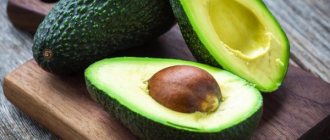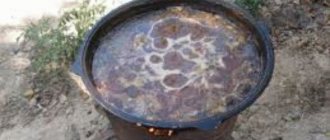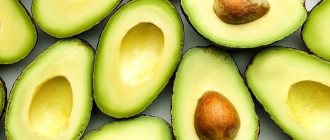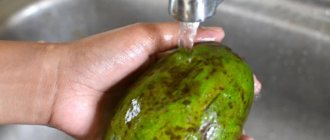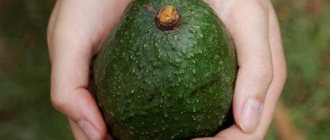Once ripened, you have a narrow window of time—usually a few days—before the fruit begins to spoil ().
You may be wondering how to tell when an avocado has gone bad and is no longer ready to eat.
Here are 5 signs that your avocado has gone bad.
How do you know if an avocado has gone bad?
Overly soft with bruised skin
When checking for ripeness, use the palm of your hand to gently squeeze the avocado. Do not press the fruit with your fingers as this may damage the flesh.
If the avocado is very hard and cannot be pressed at all, it means it is unripe. If it gives a little, it's probably ripe and ready to eat.
However, if squeezing leaves small indentations, the fruit may be too ripe to cut and would benefit from being pureed.
The fruit is overripe and probably spoiled, perhaps if pressure leaves large dents and the fruit becomes soft.
Also, if the avocado already has dents in it before you squeeze it, it has probably already started to go bad ().
Summary:
If you gently squeeze an avocado in the palm of your hand and it forms large indentations where you pressed, the fruit is overripe and likely spoiled.
Lemon juice
Another way to preserve the freshness and color of an avocado is to use lemon juice. These two ingredients complement each other perfectly and are often used together in various recipes, and therefore, despite the fact that the avocado will become more acidic, this will not spoil it at all.
Citric acid significantly slows down the oxidation process and you will just need to pour lemon juice over the rest of the avocado.
The second option is to place a large slice (circle) of lemon on top of the remaining half of the avocado (without the pit). In both cases, it is best to store avocados in an airtight container at 4 ºC for no more than 2-4 days.
Blackened peel
Some avocados undergo distinct changes in skin color as they ripen, especially the Hass variety, which accounts for about 80% of avocados eaten worldwide ().
When Hass avocados are not fully ripe, they have a bumpy, bright green skin. When ripe, it turns dark green or brown. If the skin looks almost black and the fruit feels soft when touched, it is overripe and probably spoiled.
Other varieties, including Zutano and Fuerte, retain their green skin color no matter how ripe they are. Use other methods, such as feeling for firmness, to determine whether they are ripe or spoiled.
Summary:
Hass, the most common variety of avocado, has blackened skin when overripe or spoiled. However, other varieties retain their green color when overripe.
Historical information
The history of the appearance of the fetus began 10 thousand years ago. It is assumed that the origin of the culture is connected with the agricultural tribe of Central America, which crossed several species of plants. The modern name "avocado" comes from the name of the ancient Aztec plant - "ahuacatl". Interestingly, the tender fruits are the favorite food of many land animals living in the tropics. They spend a long time looking for fallen, juicy avocados on the ground. This is where the next name of the culture came from - “crocodile pear”.
The first acquaintance of Europeans with the exotic fruit occurred in the 15th century. And in the 17th century, avocados were brought to Southeast Asia and the west coast of Africa by Spanish and Portuguese sailors. Until the beginning of the 20th century, the fruits of the evergreen tree were considered typical crops of local importance. Only at the end of the 20th and beginning of the 21st centuries did they acquire a commercial character.
Where does alligator pear grow?
Today, there are 600 varieties of avocados that grow in different parts of the world with tropical, subtropical climates (East Asia, America, Africa, Oceania). The most common types: Fuerte and Hass. They have a rich, deep buttery aroma and excellent taste. In new varieties, the weight of the fruit is 200 - 400 grams, and the pulp accounts for up to 93% of the total weight of the fruit.
Dark, striped flesh
Once you cut an avocado, it's much easier to tell if it's gone bad. Of course, this option is only suitable if you have already bought the fruit.
Avocados that are ready to eat have light green flesh. Rotten pulp has brown or black spots ().
However, an isolated brown spot may be due to dents rather than widespread deterioration and can be cut off.
Another possible sign of rotting is dark streaks in the flesh.
However, some avocados, especially those picked from young trees, may have dark streaks even if they are not rotten. If the fruit looks good and does not taste bad, it is safe to eat.
Likewise, the texture of an avocado can be uneven when it's spoiled. However, if there are no other signs of rot, this is not necessarily a bad thing. The fibrous texture can also be attributed to growing conditions ().
Summary:
Spoiled avocado flesh has dark spots and a streaky texture that tastes bad. However, isolated areas of discoloration may be associated with dents.
Pests
In indoor conditions with increased dry air, almost all plants can be attacked by spider mites. If the tips of the leaves of an avocado dry out and at first a barely noticeable mottling appears on them, then the first thing you need to do is check their back side with a magnifying glass for the presence of small black dots.
With significant damage to plants on the leaves, you can even see the smallest cobwebs with which their cuttings are covered. If there are few pests, then simply washing the leaves with warm water and potassium soap will help remove them. When cobwebs appear, avocados should be sprayed with Fitoverm, Vermitek or Actofit at least 2-3 times with an interval between treatments of 4-5 days.
Scale insects are a frequent guest on avocados. These tiny pests live primarily on plant stems or on the lower veins of leaves. They suck the juice from the green part of the avocado, causing the leaves to turn yellow and dry out. Scale insects can be removed manually using a solution with tar soap.
By taste or smell
Ripe avocados have a pleasant, slightly sweet aroma and a slightly nutty taste. As the fruit spoils, its taste and smell may deteriorate.
If it tastes or smells sour, it may have bacterial spoilage and should be discarded ().
A chemical smell and taste may mean it is rancid. This can happen when oxygen or microbes damage or break down the fruit's unsaturated fat ().
Rancidity can lead to the formation of potentially toxic compounds. Don't eat an avocado if you think it's rancid ().
The taste of spoiled avocados can vary, but it's usually easy to tell if they've gone bad based on the taste.
You can tell if an avocado has gone bad by smell, taste, touch, and visual inspection.
Summary:
A sour taste or smell, as well as a rancid aroma and chemical taste mean the avocado is spoiled and you should discard it.
Chemical composition
Avocado is the most nutritious fruit of all plant foods, with the exception of coconut. The calorie content of 1 piece of ripe fruit is 250 calories. Therefore, it is recommended to eat no more than 1/5 of an alligator pear at a time. Calorie content per 100 grams – 167 calories.
The energy ratio B: F: U is 5%: 82%: 5%.
This product is unique in composition; it contains essential unsaturated fatty acids, many vitamins, minerals, fiber, antioxidants (lutein), beta-sitosterol, which are beneficial for the human body and beauty.
Nutritional value of avocado pulp per 100 grams:
- proteins – 2 grams;
- carbohydrates – 6 grams, of which 5.3 grams are fiber, 0.7 grams are monosaccharides;
- fats – 15 grams, of which 2.4 grams are saturated lipids, 10.3 grams are monounsaturated, 2.3 grams are polyunsaturated;
- water – 73 grams.
Delicious recipe! Stair climbing muscles
Table No. 1 “Chemical composition of avocados”
| Name | Nutrient content in 100 grams of avocado, milligrams |
| Vitamins | |
| Retinol (A) | 0,03 |
| Thiamine (B1) | 0,06 |
| Riboflavin (B2) | 0,04 |
| Niacin (B3) | 0,6 |
| Pantothenic acid (B5) | 1,0 |
| Pyridoxine (B6) | 0,2 |
| Folic acid (B9) | 0,0185 |
| Ascorbic acid (C) | 7,7 |
| Phylloquinone (K) | 0,019 |
| Macronutrients | |
| Potassium | 280 |
| Phosphorus | 33 |
| Calcium | 15 |
| Sulfur | 15 |
| Chlorine | 11 |
| Magnesium | 10 |
| Sodium | 2 |
| Microelements | |
| Iron | 1,0 |
| Aluminum | 0,8 |
| Zinc | 0,29 |
| Copper | 0,25 |
| Manganese | 0,21 |
| Bor | 0,1 |
| Fluorine | 0,014 |
| Molybdenum | 0,01 |
| Iodine | 0,002 |
| Cobalt | 0,001 |
Avocado is a natural source of unsaturated fatty acids that are easily absorbed by the human body. Interestingly, the tropical fruit has twice the calorie content of beef, and the amount of vitamin F (omega-3.6) is three times higher than fish oil. In addition, avocado pulp contains five times more tocopherol than olive oil. It’s not for nothing that the Indians of South America call the fruit “forest oil.”
How to eat it raw?
The avocado is cut lengthwise around the pit; the skin is not peeled. After dividing the fruit into two hemispheres, take out the seed by prying it with the tip of a teaspoon. The part of the fruit planned for consumption is peeled.
Mold
Mold on avocados is usually white or gray and has a fuzzy appearance. Do not inhale it, as you may inhale mold spores and cause breathing problems if you are allergic to it.
Avoid buying avocados with mold on the outside, as it can penetrate into the flesh and cause the entire fruit to spoil.
If you cut an avocado and see mold, discard the entire fruit. Although you may only see mold in one area, it can easily spread through the pulp. Do not try to save the fetus ().
Summary:
Mold is a clear sign that the avocado has gone bad. You should discard the entire fruit as mold may spread through the flesh but may not be completely visible.
How much can you eat per day?
For many adherents of a healthy diet, avocado is an indispensable product for daily consumption, however, being a high-calorie fruit, you need to know how much of it you can eat per day.
Nutritionists advise eating avocados every day, but only if the quantity does not exceed one. It is worth remembering that excessive consumption of a high-calorie product can affect your figure and well-being: cause heaviness in the stomach, nausea, and a feeling of discomfort.
Safety of overripe avocados
Whether an overripe avocado is safe to eat depends on the type of decomposition and how long it remains overripe.
Since ripening begins at the end of the stem and progresses downwards, you can use part of the overripe fruit if the flesh has just begun to brown.
However, do not eat the discolored parts of the avocado as they will not taste good. Also, do not attempt to salvage any part of a rancid, sour-smelling, or moldy avocado, as this may make you sick (, ,).
Keep in mind that once you cut an avocado, the flesh will begin to brown due to exposure to oxygen. This is a natural process similar to how apples turn brown when sliced. If you find it unappetizing, peel off the brown layer and eat the rest ().
To minimize darkening of cut areas, brush the pulp with lemon juice and store in the refrigerator in a sealed container.
By keeping an eye on your avocado and storing it in the refrigerator to slow down the ripening process, you can reduce waste.
Overly soft but unspoilt avocados are safe to eat and can be used in guacamole, smoothies, salad dressings and baked goods.
Summary:
If an overripe avocado tastes great, you can eat it, but be sure to avoid spoiled ones. The more an avocado deteriorates, the more likely it is to become rancid or moldy, which can make you sick.
How to clean the outside
How to clean the outside of a non-stick frying pan? Preference should be given to household chemicals. Try to clean in such a way that detergents do not get inside the pan.
Choose special concentrates and sprays for non-stick pans. The concentrate must first be foamed, applied to the outside of the dishes and left for 15-20 minutes, and then rinsed thoroughly with water and a soft kitchen sponge. It is more convenient to use a spray: it is sprayed directly from the container onto the contaminated surface, and after 5-10 minutes it is washed off with water.
If the pollution is not too strong, you can use traditional methods. Knowing how to clean the outside of a frying pan with a non-stick coating from carbon deposits at home, you can do this without much difficulty:
- Take a large saucepan and pour water into it. Add grated shavings from two pieces of laundry soap, as well as two packs of baking soda. Place a frying pan in a soap-soda solution, put the pan on the fire and boil for two hours. After this, turn off the heat, let the contents of the pan cool, and remove the pan. Soot and stubborn fat should be easily removed with a soft sponge or piece of cloth.
- Pour 3 liters of clean water into a large container. Add 50 ml of office glue, 100 ml of detergent, 150-200 grams of soda. Place the frying pan in the resulting solution, hold for several hours, then rinse the frying pan under water. Remove heavy dirt with a sponge.
Summarize
- An avocado is spoiled if it is soft when squeezed, brown or moldy inside, and it tastes rancid or smells sour.
- You can salvage some of the fruit if it is just starting to brown inside, but the rest of the fruit looks and smells and tastes great.
- Inspect your avocado carefully in the store and keep a close eye on it at home to avoid having to throw it away.
The article was prepared by experts for informational purposes only. It should not be used as a guide for treating medical conditions and is not a substitute for professional medical advice, diagnosis, or treatment. In case of illness or any symptoms, you should always consult a doctor and not self-medicate.
Tags: Avocado
About the author: Alexander Fedorov
Candidate of Biological Sciences, biologist, nutrition expert. Graduated from Stavropol State University with a degree in Biology at the Faculty of Biology and Chemistry.
- Related Posts
- Kiwi: benefits and harm to the body, how much to eat
- Raspberries: beneficial properties and contraindications
- Grapefruit: benefits and harm for the human body
« Previous entry
Effect on the body
Indications for eating avocado:
- hypertension;
- diabetes;
- gastritis with low/high acidity;
- catarrh of the stomach;
- dispersion;
- constipation;
- avitaminosis;
- cataract.
Despite its high calorie content, the oily fruit is recommended to be included in the diet of patients who have suffered infectious diseases to strengthen the immune system.
- Cleanses the digestive system of waste and toxins, reduces the level of cholesterol cells in the body by 3 times. In addition, avocado pulp contains the amino acid L-carnitine, which burns fat, speeds up metabolism and promotes weight loss.
- Increases the body's resistance to ARVI pathogens.
- Normalizes blood pressure, concentrates memory, prevents the development of atherosclerosis, thrombosis, arthrosis, and anemia.
- Maintains eye health, visual acuity, fights free radicals that destroy cell membranes and cause inflammatory reactions and cancer.
- Moisturizes, nourishes the skin, relieving it of dryness, and saturates it with nutrients.
- Strengthens and restores hair.
- Prolongs the youth of the body, both outside (smoothes wrinkles) and inside (supports internal organs).
- It has a positive effect on the nervous system: improves the generation and transmission of impulses, reduces irritability, fatigue, and increases performance.
- Has a stimulating effect and enhances sexuality.
- Increases physical endurance, has a tonic effect, strengthens the immune system, and increases stress resistance.
Due to the fact that avocado destroys malignant cells, the exotic fruit is of particular value for women during menopause, as it can prevent breast cancer. The oily fruit is also irreplaceable for men after 40 years of age, when testosterone production decreases and the risk of developing a prostate tumor increases. Alligator pear resists these changes and prevents cancer of the genital organs.
In addition to the pulp of the fruit, the seeds and leaves of the fruit tree exhibit beneficial properties. They are used to treat intestinal diseases: enterocolitis, chronic colitis, dysentery.
How many avocados to eat per day?
To maintain health, it is recommended to eat one ripe fruit per day or at least eat it once every 2 days.
- individual intolerance;
- disruption of the pancreas and liver;
- allergies to latex or citrus fruits;
- tendency to obesity.
Remember, avocado seeds cannot be crushed and added to dishes, as they contain toxic substances that poison the body and cause asphyxia.
Blackening and drying of leaves
Now let’s figure out why avocado leaves and stems turn black and dry. This happens if there is a violation of the growing conditions: there is not enough light, moisture in the air, the pot is too small, the sprout is not transplanted correctly, there is a lot of moisture in the soil. We must not forget that the avocado is a tree, it must grow and develop in the wild or in the garden. In containers when grown indoors, the plant is cramped, so the tips of the avocado leaves dry out. Without careful care, nothing will work; the plant will not survive.
So, the avocado leaves are drying, what to do:
- transplant the plant into a pot whose diameter is 2-3 cm larger;
- Spray the air at least 5 times a day when the plant is near heating radiators in winter, where the air is dry;
- Water the soil in the pot as the top layer dries 3-5 cm.
Soil and air humidity
When answering the question of why avocado leaves dry out, we focus on the fact that both dry soil and excess water are detrimental to the plant. Constantly being in wet soil leads to rotting of the roots. To prevent this from happening, you should carefully, without damaging the integrity, remove the lump of earth with the plant from the container, wrap it in paper and place everything under diffused light to dry the earth and get rid of excess moisture. The roots should be inspected, rotten ones should be cut off and the plant should be returned to the pot.
The humidity of the room (room) should be up to 40-60%. In dry air, the tips of avocado leaves dry out and curl. To eliminate this, you need to place a container of water, an aquarium, and moistened moss and expanded clay on the windowsill. You can use an electronic humidifier to relieve dry air.
It should be watered once a week, adding Kornevin to the water according to the instructions. Avocado is sprayed with the addition of Epin, an artificial analogue of a plant biostimulant created by nature. It increases the crop’s immunity to temperature changes, dry air, lack or excess of moisture, and activates the defenses of the plant itself.
Lighting and temperature
As for lighting under normal watering conditions, the tree is comfortable being under diffused light, on the windowsills of southern windows. Lack of light and hypothermia lead to the death of the plant. On a light-colored windowsill, it should be protected from direct ultraviolet radiation and generously sprayed. This eliminates drafts and maintains the temperature at 15-20°C. Sometimes a flower tree is placed under a greenhouse.
A sharp increase in temperature should not be allowed; the avocado may suffer. In winter, all cracks in the windows should be sealed with paper, and foam or a warm fabric pad should be placed under the pot. This will protect the roots from freezing and disease. At the same time, drafts are eliminated, heating devices are placed, containers with plants are moved to window sills where there are no heating radiators.
In cool rooms, the leaves shrink, but they become darker rather than yellow. Cold slows down growth and the plant slowly fades away. Therefore, when folding the leaves, you can try to revive the tree by adjusting the air temperature in the room. It is gradually brought to 15°C; there should be no sudden temperature changes. But do not forget that you cannot place containers with culture near thermal appliances and radiators. Due to dry air, the leaves turn yellow, become hard and smaller. It is also necessary to reduce the air temperature gradually, while watering it moderately rather than flooding the soil.
Conclusion
Avocado is an exotic fruit that contains the entire set of B vitamins, nutrients A, D, E, C, PP, minerals: phosphorus, sodium, magnesium, potassium, manganese, calcium, iron. Despite its high energy value (167 calories per 100 grams of pulp), the fruit is considered a dietary product and is recommended for daily consumption by all healthy people.
The beneficial properties of avocado are due to the high content of the following nutrients:
- antioxidant glutathione, prolongs the youth of the body;
- lutein, protects the organs of vision from cataracts, macular degeneration of the retina;
- beta-syntosterol, lowers cholesterol levels;
- folic acid, strengthens the heart.
How to choose a ripe avocado?
- The skin of the fruit must be clean, without stains, cracks, dents, or damage.
- The color of ripe fruit is uniform, close to black.
- When pressed, the fruit should squash slightly.
Green avocado tastes like an unripe pear or pumpkin, has a hard peel and dense flesh. The ripe fruit has a subtle nutty aftertaste, reminiscent of a puree of butter and herbs.
How to ripen green avocado at home?
To improve the taste and soften the texture, do not put the fruit in a cold place, store it at room temperature. It will ripen in 2 – 3 days.
Onion
This method is as follows: you need to cut a quarter of the red onion into large pieces and place them on the bottom of an airtight container. Then you can put the half of an avocado that you have left unused there, so that the pit faces up. Close the container with a lid and place it in the refrigerator.
This tip is very effective, and the whole point is that the vapors that come from the onions allow you to preserve the natural green color and freshness of the avocado. In addition, the only part that comes into contact with the onion is the avocado peel, which means such storage will not affect its taste in any way. Yes, and chopped onions can also be used for other purposes.
Tags
Avocado darkens Avocado darkens part of avocado is the benefits of avocado the benefits of avocado avocado also enjoy avocado and why avocado becomes oxidation of avocado store avocado longer oily pulp can pit the pulp is always not pulp. so that the pulp is not why the pulp darkens that the pulp is exotic to pulp of itbuy the fruit.chopped fruit in this is the fruit of the plantgreen fruit with the cut fruit freshcut fruit preservedcut of the fruit.oil the fruit is also a tropical fruit contains an exotic fruit will absorb
tastewhatreadfatwantgrams
Parasitic insects
Scale insects and spider mites damage the crop. They have the same effect on the tree: the leaves begin to turn yellow and fall off, and the crop quickly dies. To prevent the reproduction and spread of parasites on twigs and leaves, you need to spray with a soap solution, as well as Actofit or Vertimek three times, every 5 days. But before that, it is recommended to humidify the air.
For the soap solution you will need: grated laundry or potassium soap - 100 g/1 liter of water.
The ground before the soapy shower should be covered with film. The crown with all parts of the plates is moistened abundantly, washing away parasites.
Important! Healthy plants should be fenced off from diseased ones. At the same time, you need to inspect your brushes; they may contain parasites. They migrate not only through the air to healthy parts of plants, but also cling to clothing and the skin of the hands.
The spider mite lives in dry rooms; on the green mass of the tree it begins to weave a thin web, causing the greenery to dry out and the tips of the leaf blades to turn yellow. If you look at the back of the plates with such symptoms through a magnifying glass, you will notice black dots.
Store it with onions
Place the avocado half in an airtight container or bowl covered with plastic wrap in the refrigerator. But before that, pour a quarter cup of finely chopped onions into the bottom of the bowl.
Yes, those same sulfur compounds that make you cry when cutting onions will serve as an excellent antioxidant for avocado pulp. This method definitely works for one or two days.
Lubricate the cut with olive oil
The principle is the same: protect from contact with oxygen. Brush the cut side with oil with a pastry brush or spray with oil from a spray bottle. As a last resort, just dip the fruit in a bowl of oil and then put it in the refrigerator. The method also lasts one to two days.
Lemon juice will also help
Another way to preserve avocados is to use lemon juice instead of olive oil. But in this case, you need to wrap the avocado half tightly with plastic wrap so that the juice does not dry out. And in the refrigerator. It will also help for one or two days.
The shelf life of avocados without additional manipulation is 1 week. You can even store cut avocados, but in this case you need to be smart. The fruit is rich in iron and other trace elements, so if its integrity has been compromised, the pulp will oxidize very quickly. If the “alligator pear” (also called avocado fruit) turns black after cutting, it can no longer be used as food.
For all lovers of salads, smoothies and other culinary dishes made from avocados, we present a rating of the most effective life hacks - ways to increase the shelf life of the cut fruit.
Is it possible to eat an avocado that is brown inside and what to do if it’s bitter?
Avocados are grown in areas with tropical and subtropical climates. After harvesting, the fruits do not immediately reach store shelves. During transportation, part of the harvest spoils, so owners often collect unripe fruits. Violation of storage or transportation conditions can lead to loss of taste and change in structure. Whether an avocado is black inside or not is a question that worries consumers who choose vegetables and fruits in supermarkets and retail outlets.
What are black spots inside an avocado?
The appearance of black dots inside is associated with technical ripeness. Ripeness is determined by several criteria:
- the mark from light pressure quickly disappears, the shell takes its previous shape;
- the area where the cutting was located becomes green, with brown spots;
- when pressing on the handle, the oil accumulated inside may seep out;
- when shaking inside, you can hear the tapping of the bone;
- The bone is easily separated from the pulp: it can be removed with a spoon.
The appearance of the peel will not say anything about the ripeness or safety of the pulp inside. Depending on the variety, the peel has green, brown and intermediate colors.
Whether an avocado can be eaten can be determined by the color and structure of the pulp. If the pulp is covered with black dots inside, this may indicate a violation of storage rules. The appearance of black spots occurs due to the fact that the fruit was first stored in a cold room, and then it gets into the heat.
The answer to the question whether it is possible to eat pulp with black dots inside also depends on how much blackness is spread over the surface. If the black spot is located far from the seed and the area covered by it is approximately 10% of the total, then such fruit can be removed by first removing the black spots with a spoon. Small black dots are picked out with the sharp tip of a knife, and then the pieces of pulp are used for their intended purpose. Such pieces will not taste bitter or have any other unpleasant taste.
If the black spot completely surrounds the pit on both halves, and when removed it turns out to be widespread at all levels within the pulp, then the fruit should not be eaten. In this case, there are several reasons for the appearance of black spots:
- sudden change in climatic conditions during storage;
- long stay at low temperatures;
- violation of transportation methods;
- possible stay in water and subsequent drying.
A black spot is evidence of overripeness. With maximum spread, it threatens the fruit with loss of taste and beneficial properties. It is better not to eat such fruit, since, most likely, it will taste bitter and, in addition, will lose its beneficial properties.
Is it possible to eat a darkened avocado?
Avocado has long been considered an exotic fruit, but recently its presence on supermarket shelves has become commonplace. Despite this, consumers are not fully familiar with the characteristics of this culture. Many people are frightened by the ability of the fruit to darken after cutting. In fact, there is nothing wrong with this. The fact is that the pulp contains an increased amount of iron inside. Upon contact with air, an oxidation reaction begins. This causes the cut halves to darken.
What do you need to prevent avocados from turning dark?
To protect the pulp from darkening for a while, sprinkle it with lemon juice. This will delay the oxidation process.
Another method that helps prevent darkening is to generously lubricate the cut halves with olive oil. After this, the unused parts are stored in an airtight container in the refrigerator.
Why is avocado bitter?
Often, after successfully choosing a fruit, it turns out that it tastes bitter when consumed. If, in addition to bitterness, the avocado contains brown streaks inside, this means that the fruit is completely overripe. There will be no benefit from its use, and you should not eat it. In addition, the taste of dishes prepared with it will suffer.
The second reason for the appearance of bitterness may be the unripeness of the avocado: in this case, it will be light yellow inside, with a bitter taste.
The pulp also begins to taste bitter after heat treatment. Usually people start eating it raw, so as not to expose it to high temperatures, which destroy the structure and contribute to the loss of beneficial properties.
Is it possible to eat avocado if it tastes bitter?
Unripe or overripe fruit usually tastes different. Overripe fruit compensates for the bitterness with an oily and soft texture.
An unripe avocado will be bitter inside to such an extent that it will simply be impossible to enjoy eating it. Bitterness does not mean that the fruit loses its beneficial properties or becomes harmful: it is just a sign of the level of ripeness and a characteristic of taste.
What to do if your avocado is bitter
If the fruit is overripe, it will definitely taste bitter. You can mask this taste with additional ingredients. It all depends on the skill of the cook or housewife.
If the avocado is bitter due to insufficient ripeness, then you can leave it for several days to lose bitterness through ripening. For this purpose, you can use one of several methods.
- Place the pieces in a container, sprinkling generously with lemon juice. After 3–4 days after storage, the fruit will no longer taste bitter and can be eaten.
- Uncut fruit should be left to ripen. To do this, it is wrapped in food paper and put away for several days where it is dark and dry.
Conclusion
Whether an avocado is black inside or not is decided depending on the reasons for the appearance of black spots. Small black spots on the surface of a fresh fruit will not cause harm. A spreading black spot, which is a precursor to the rotting process and evidence of spoilage, is a signal that such a fruit should not be eaten. In addition, you should know that unripe avocados can be bitter and hard, so the best option would be to leave such fruit to ripen.
